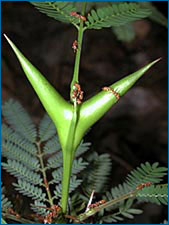The term coevolution is used to describe cases where two (or more) species reciprocally affect each other’s evolution. So for example, an evolutionary change in the morphology of a plant, might affect the morphology of an herbivore that eats the plant, which in turn might affect the evolution of the plant, which might affect the evolution of the herbivore…and so on.
Coevolution is likely to happen when different species have close ecological interactions with one another. These ecological relationships include:
- Predator/prey and parasite/host
- Competitive species
- Mutualistic species
Many cases of coevolution can be found between plants and insects. For example, plants and their pollinators are so reliant on one another and their relationships are sometimes so exclusive that biologists have good reason to think that “matches” between the two are the result of a coevolutionary process.

Another example involves Central American Acacia species, which have hollow thorns and pores at the bases of their leaves that secrete nectar. These hollow thorns are the exclusive nest-site of some species of ant that drink the nectar. But the ants are not just taking advantage of the plant — they also defend their acacia plant against herbivores.
This system is probably the product of coevolution: the plants would not have evolved hollow thorns or nectar pores unless their evolution had been affected by the ants, and the ants would not have evolved herbivore defense behaviors unless their evolution had been affected by the plants.
Learn more about coevolution in context: Biological warfare and the coevolutionary arms race, a case study.
